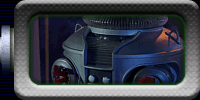




 |
|
| Robot Reference->Construction Tips->Texturing the Torso | |||
By Mark Thompson
Start
by making sure you have no flaws in the surface. While the texturing
will hide small imperfections, it won't mask glaring mistakes. After
the surface is primed, spray on one coat of Plasti-Kote Fleck Stone
faux granite finish. This is a water-based product, so it cleans
up with just water. That's a good thing, because the stuff flies
everywhere! Be sure to mask off and cover anything nearby that you
don't want to have a faux finish. Spray in short sweeps and short
bursts. You want to achieve even coverage, but let about 50 percent
of the primer show through. The product has a tendency to collect
in corners, so it's a challenge to go back and even out thin spots
without building it up in other spots. Practicing on another object
would definitely be helpful. Once you have a satisfactory coat sprayed
on, let it dry overnight. The Fleck Stone stays wet for a long time,
so for heaven's sake don't touch it!
When
the primer is dry, apply a light coat of your silver paint. Let
this dry and then repeat your sanding routine. This time you can
bear down harder, because the paint will further seal the texture
and create a hard surface. Flatten down the bumps as much as possible
without making it completely smooth, although you'd be hard pressed
to smooth it out completely. You're aiming for something like the
peel of an orange.
|
|||








 Texturing
the Torso
Texturing
the Torso


